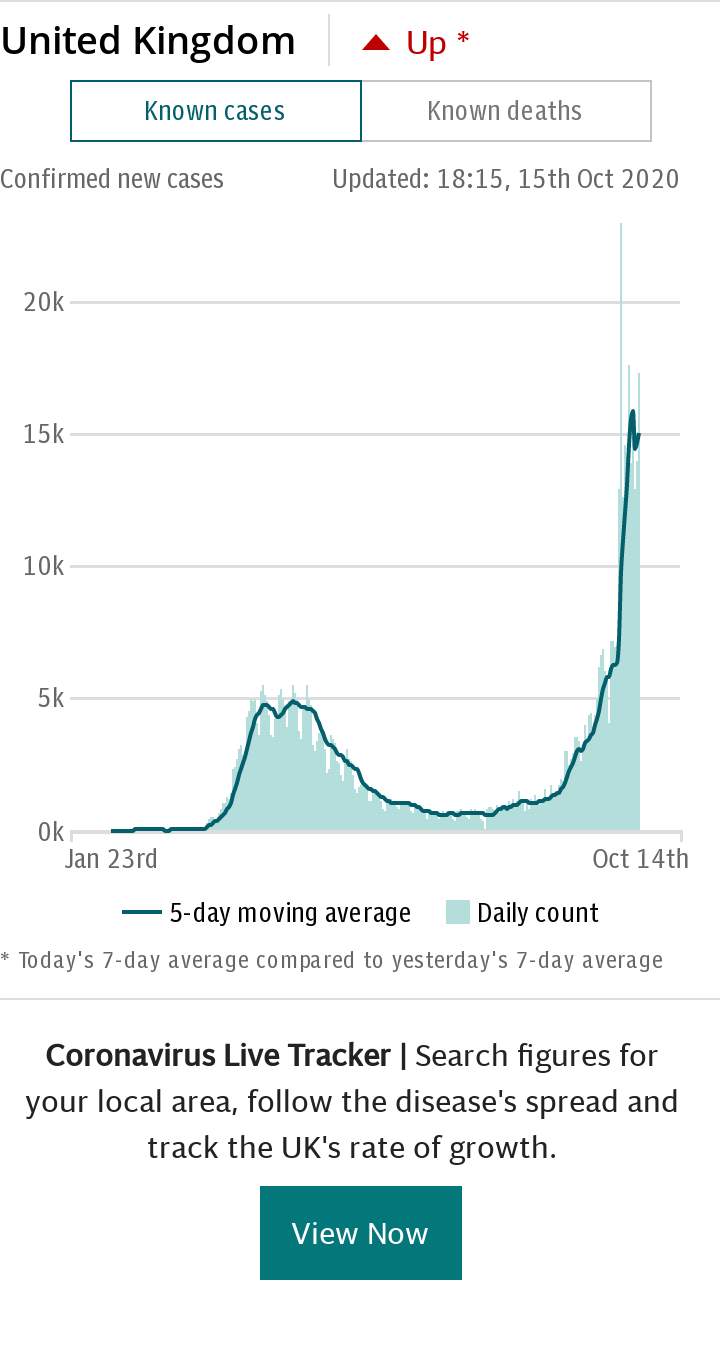Coronavirus infections are surging among the over-fifties


Coronavirus cases are surging among the over-fifties, according to government figures seen by the Telegraph.
Senior officials have warned of “worrying” signs for higher risk groups, with Public Health England (PHE) data revealing that infections increased 92 per cent among those in their fifties last week, 72 per cent among sixty-somethings, and 44 per cent among those in their 80s.
It came as Birmingham was ordered back into lockdown amid warnings that Covid-19 cases are now spiralling across the UK in a way last seen in March.
Until Friday, it looked as if the rise in infections, driven principally by young adults, was not yet affecting the most vulnerable older groups.
However, the new PHE figures appear to justify experts’ fears by showing recent increases in hospital admissions among people aged 60 and over.
There was a 20 per cent increase in Covid-19-related admissions last week compared with the week before among those aged 60 to 75, a 72 per cent increase among 75 to 84-year-olds, and a 67 per cent increase among those aged 85 and over.
A PHE source said this had not yet followed through to intensive care unit admissions, but added: “the great worry is that that is what’s coming next.”
Overall, there were 1,635 new cases among people aged 50 and over in England last week, compared with 915 the previous seven days.
Yvonne Doyle, PHE medical director, said 3,539 new Covid-19 cases were reported on Friday compared with 2,919 the day before.
“Although younger people continue to make up the greatest share of new cases, we’re now starting to see worrying signs of infections occurring in the elderly, who are at far higher risk of getting seriously ill.
“This is a reminder of the ongoing risk as the virus spreads throughout the UK. People should continue to follow social distancing rules, wash their hands regularly, and wear a face covering in enclosed spaces. You should not mix with others when unwell.”
From Tuesday, households in Birmingham, Sandwell and Solihull will be banned from mixing both in public places and in private homes.
It came as surveillance showed the R rate may now be as high as 1.7 in England, with infection rates doubling on a weekly basis.

Government sources said the rate of increase is similar to that seen in early to mid-March, before the country went into lockdown, with the reproduction rate clearly above one for the first time since then.
They said the figures were “a wake-up call”, suggesting that if the 'rule of six' fails to slow the spread of disease, further restrictions could see the imposition of curfews, closures of pubs and restaurants, or more widespread restrictions on mixing between households.
Other estimates published on Friday suggest both England and the UK have a rate between 1 and 1.2, but this data carries a time lag, experts warned.
The Government has already ordered the imposition of strict restrictions on Birmingham, amid growing concern over the city’s increasing number of Covid-19 cases.
The weekly infection rate in the city is now higher than it was during the coronavirus lockdown, jumping from 61.5 per 100,000 in early April to 80 per 100,000 in the first week of September.
The city's director of public health Dr Justin Varney said the increase was "linked primarily to private household gatherings" at the end of August and during the bank holiday weekend.
The mayor also said younger people "had got to take responsibility" with the biggest growth in age groups under 40.

The current positive infections tally puts Birmingham third in a national table of local authority areas of highest infection rates, behind Bolton and Sunderland.
The virus is “no longer clustering in healthcare or care home settings”, officials said on Friday, warning that the outbreak is now on the march in the community in “all areas” of the country.
Data from the Imperial College London REACT study shows that infection rates are increasing in all adult age groups below the age of 65.
The highest rates of infection were in young people aged 18 to 24, and the worst areas are currently Yorkshire and the Humber, the North East and the North West.
This appears to correspond with warnings from some experts that young people attending illegal house parties and non-socially distanced events are driving the uptick.
The new figures are drawn from a cohort of up to 150,000 volunteers evenly distributed across the country, who undertook swab testing for current infection between August 4 and September 7.
Prevalence of the disease is now doubling every 7.7 days, with a national prevalence for England of 0.126 per cent, compared to 0.040 per cent up to August 8.
The data comes ahead of the government’s first reimposition of national restrictions, due to start on Monday, which include a 'rule of six' limit on family and social gatherings.
Prof Paul Elliott, director of the Imperial programme, said: “What we are seeing is evidence of an epidemic in the community and not a result of increased testing capacity.
“This is a critical time and it’s vital that the public, our health system and policymakers are aware of the situation as we cannot afford complacency.”
Separate data from the Office for National Statistics (ONS) suggests that around 1 in 1,400 people had Covid in the week ending 5 September, up from 1 in 2,000 a week before.
An R (reproduction) value of 1.7 means that, on average, every 10 people who contract Covid-19 will in turn infect 17 others.
Matt Hancock, the Health and Social Care Secretary, said: “We’ve seen all across the world how a rise in cases, initially among younger people, leads to hospitalisations and fatalities.
“The pandemic is not over, and everyone has a role to play to keep the virus at bay and avoid further restrictions.”

 Yahoo Movies
Yahoo Movies 